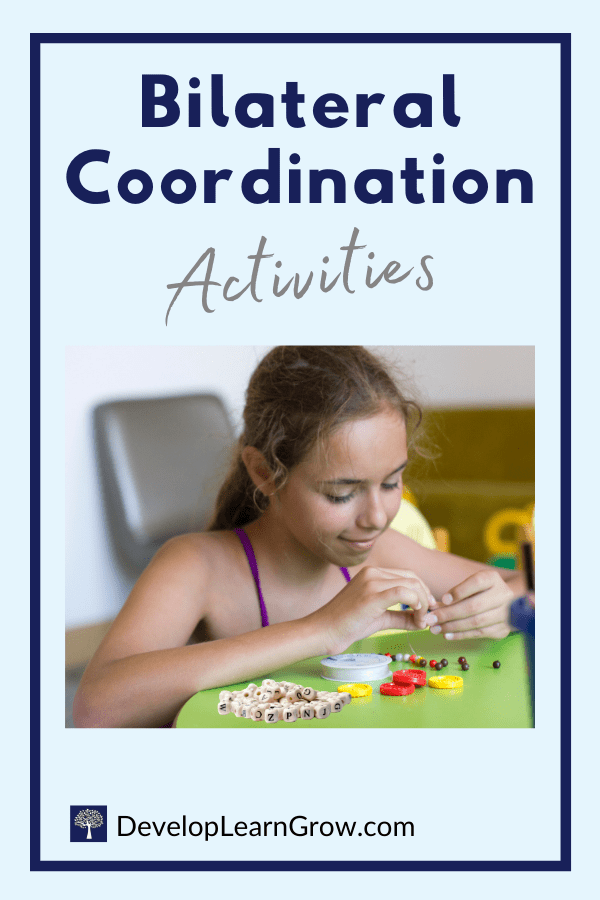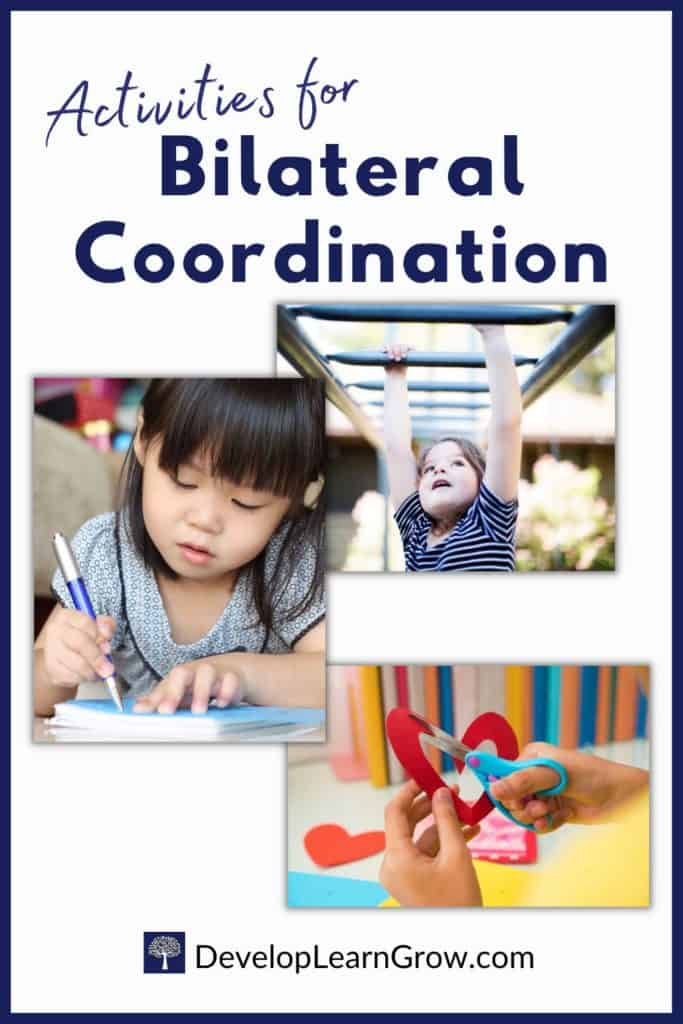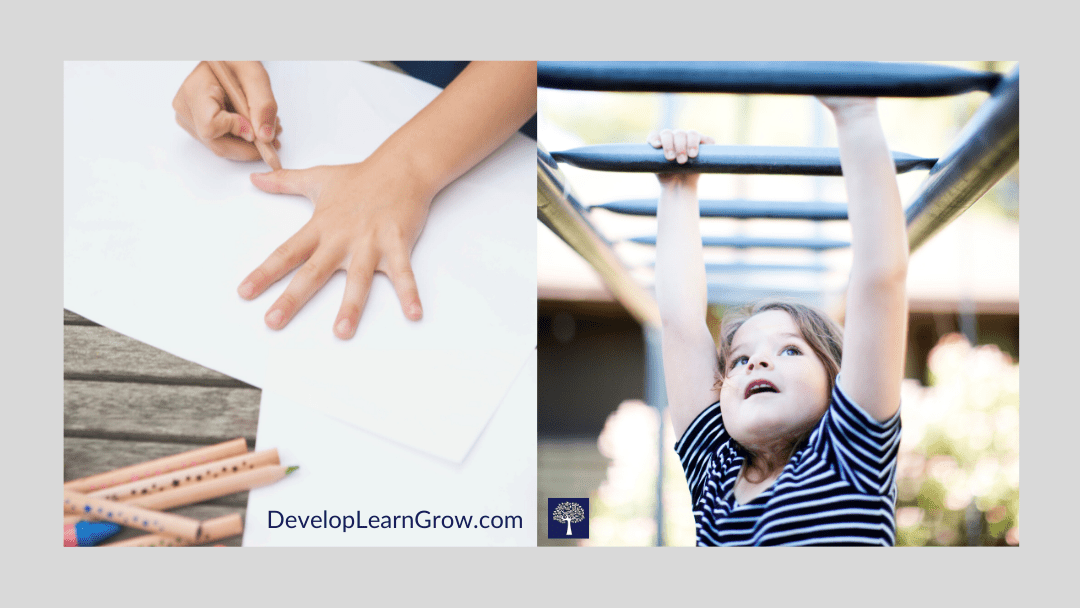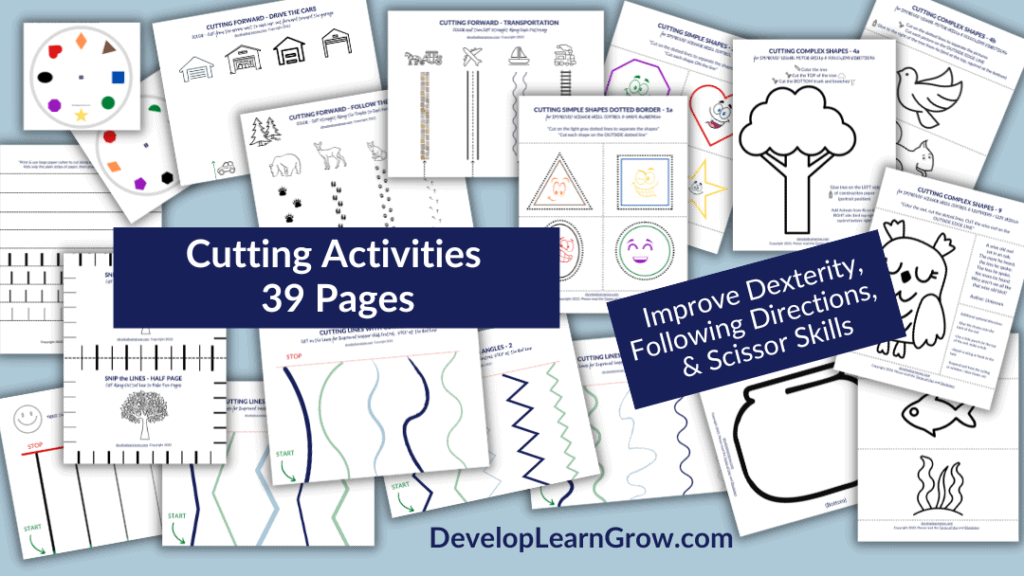Bilateral coordination activities are important for kids when they play and learn. These 5 suggestions are simple and easy to do!
Bilateral coordination skills are needed for motor development and brain development.
These skills start when kids are young but continue as they grow.
As adults, we still use bilateral coordination. From chopping veggies during dinner prep to scrubbing a pan after, coordination of both hands is needed.
Also, when climbing a ladder to hold a paint container in one hand and the brush in the other.
Or, those challenging moments of assembling IKEA furniture with drawers!
Bilateral coordination is required in life! It’s important to start developing these skills when kids are young.
What is Bilateral Coordination?
Bilateral coordination (bilateral integration) is the ability to use both sides of the body to complete daily tasks.
Babies move their entire arms at the same time. They reach and grasp items that are closest to each hand. Hands are used equally.
As they progress into toddlerhood, hand preferences start to develop (between ages 2 and 4.) Kids will typically still switch hands for various fine motor tasks at this age.
Hand dominance typically is evident between ages 4 and 6. You will see kiddos consistently use one hand for a task. The other hand is the stabilizer or helper.
Bilateral coordination happens as the arms work together for symmetrical movements such as catching a medium sized ball or pulling up a sock.
Or, they work in opposition during reciprocal movements such as crawling or swinging on monkey bars.
Kids use more refined coordination skills when the hands perform different actions. For example, when fastening nuts and bolts or when tying shoes.
One hand stabilizes an object… the other does the work. One is the “helper” and the other is the “worker.”
When Do Kids Use Bilateral Coordination Skills?
Bilateral coordination skills are evident in many daily fine motor tasks.
Examples of bilateral coordination tasks:
- Coloring, drawing, writing
- Cutting activities
- Dressing
- Tying shoes
- Manipulating clothing fasteners
- Fastening belts and buckles
- Managing a back pack or lunch box
- Opening containers
- Eating and cutting food
- Unlocking a door with a key
- Playing with building sets and tools
- Dressing dolls
- Making jewelry

Why are Bilateral Coordination Activities & Games Important for Kids?
Bilateral coordination activities require both sides (hemispheres) of the brain to work together.
The brain communicates effectively and automatically integrates movements of both legs and/or arms.
Crossing midline is important for bilateral coordination. The dominant hand does the work, but it also has to effectively cross the midline of the body.
[Easy Visual Tracking Activities Using the Infinity Loop further explains crossing midline. Additionally, it gives midline crossing activities for learning.]
Increasing communication of both sides of the brain is extremely important for learning!
Additionally, bilateral coordination is an important part of fine motor development. Kids need fine motor skills for daily learning and play tasks.
For more info on fine motor development, check out 3 Quick Tricks to Improve Fine Motor Skills on Your Kids’ Table. The author, another occupational therapist, includes bilateral activities in her list of fine motor activities and games.
Some of the activities listed below also require focus and concentration from kiddos… simple ways to increase attention. 🙂
5 Bilateral Coordination Tricks, Activities & Games for Kids
#1 Place Toys, Supplies and Manipulatives in Bags or Containers
This is such an easy trick to encourage bilateral coordination!
Placing toys or supplies in bags or containers not only helps organize materials – but it helps build skills.
Use Ziploc bags, zippered bags, strings on bags, etc. Store supplies, manipulatives, small toys or puzzle pieces. Kids have to coordinate both hands more often to open the bags and get their objects… and then again to put them away!
Containers with peeling lids help with fine motor strength and perceptual skills.
Lids that screw on and off are even better for bilateral coordination. Try to find containers with lids of all sizes.
#2 Cutting Tasks with Paper – A Great Activity for Bilateral Coordination
Cutting is not just for preschool and kindergarten! It’s a great bilateral coordination activity for kids of all ages. Cutting activities get both sides of the body and brain working together. Perfect for learning!
For younger kids, tearing construction paper for fine motor skills crafts is a great pre-cutting activity. Especially if they’re not ready for scissors. (Older kids love this craft as well – it’s a great relaxing brain break.)
You can also check out an entire post with tips and tricks to help kids build scissor skills.
It contains a fun bundle of worksheets for cutting practice or individual skill set pages if you don’t want all 39 pages!
WORKSHEETS FOR CUTTING PRACTICE: Click the photo or this link for more information on the cutting bundle! It’s only $11.50 on my site for the entire bundle. Smaller page sets are $2.00-2.75.
Or you can purchase them on my Teachers Pay Teachers Store (but they’re a little more pricey there.)
#3 Tracing Activities – Encourage Bilateral Coordination, Force Modulation, and Crossing Midline
Coordination is required when kids trace an object for cutting or trace geometric stencils for math.
Tracing is a great way for the non-dominant hand to stabilize a stencil or template.
Just the right amount of pressure from the helper hand is needed… as less pressure and precise movements are required from the dominant hand. (Force modulation is important for writing skills.)
Depending on the size of the template and its position in front of the body during the task, it can also encourage crossing midline.
# 4 Stringing and Lacing Coordination Activities
Stringing beads or lacing cards encourages bilateral integration.
Using beads of various sizes challenges kids depending on the shape and the length of the bead. Beads with long openings require more fingertip precision to thread the string. Smaller beads work on grasping skills.
I like using number beads or letter beads to add a learning component.
Lacing cards with string or pipe cleaner requires coordination of the hands and fingers.
For younger kids, pushing pipe cleaner or cotton balls through openings in cardboard or the lids of containers also works on strengthening. This is an easy way to work on matching.
# 5 Gross Motor / Large Movement Bilateral Coordination Activities
Gross motor movements, or big movements with large muscle groups, activate more neurons in the brain.
Coordinating BIG muscles helps with coordination of smaller muscles in the hands. Kids need strong cores in order to use large movements (40 core exercises.)
These activities are also wonderful brain breaks for kids. (Click the link for quick and easy brain breaks- activities in the free printable involve bilateral coordination.)
Activities such as marching, skipping, riding a bike and crawling are great large (gross) motor bilateral coordination activities.
On a playground, you can encourage climbing walls, climbing ladders or jungle gyms.
In addition, monkey bars give great proprioceptive input (this link also contains another free printable with 25 proprioceptive brain break activities.) This input is calming and organizing for your high energy kiddos!

Considerations for You When Kids are Performing Bilateral Coordination Activities
As adults, we naturally want to help kids. However, helping too much can actually interfere with skill development.
And sometimes, we don’t even realize that we’re helping them with the task!
For example, something as simple as holding the paper still while a child cuts… or keeping a container still so they can remove the lid… interferes with their bilateral coordination.
Moreover, providing assistance with a task that seems tricky for a kiddo, actually prevents the child from problem solving, adjusting motor movements and learning from each step of the task.
The more kiddos can feel and problem solve independently, the better it is for brain development!
So, try to help… by not helping!
Related Posts with More Skill Building Occupational Therapy Activities for Kids
How to Promote Grasp Development with 5 Types of Activities – easy ways to improve fine motor skills for grasping… without using a drawing tool!
An Easy Visual Motor Activity Using Magnets – this post also shows a fun way to incorporate bilateral integration into learning tasks. (Plus many other skills needed for learning!)
Art Projects & Crafts for Kids – A Great Way to Support Learning & Development – find fine motor, visual motor and bilateral coordination activities in this post.
Simple DIY Math Manipulatives for Tactile and Kinesthetic Learning – use household items for math manipulatives to help develop fine motor skills.




0 Comments